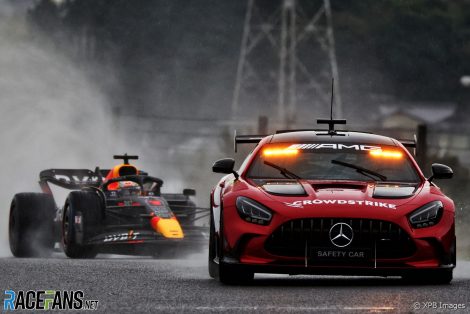Once, the prospect of rain during a Formula 1 race always added to the intrigue and excitement surrounding a grand prix.
Changing conditions plus reduced and unpredictable grip levels increase the challenge and make it easier to appreciate which drivers have the skills to master their cars.
But in order for that to be true the drivers need to be on the track in the first place. That is happening less frequently when rain hits.
Last weekend’s Japanese Grand Prix was the latest example. A two-hour hiatus occurred when heavy rain fell at the track. Thanks to that, plus F1’s unnecessarily restrictive three-hour time limit, Japan’s enthusiastic fans saw barely more than half a grand prix.
Race winner Max Verstappen is convinced F1 has become less willing to risk racing in very wet conditions.
“When it rained like it did when the red flag came out, and you would have put [full wet] tyres on, I think it would still be really difficult to drive,” he said. “But then if you compare that to 20 years ago, that would have been perfectly fine. So there must be a solution.”
Verstappen’s criticism of the wet weather tyres is borne out entirely by what happened on Sunday. Drivers left the pits to restart the race on full wets because they were required to by the rules. However as soon as the Safety Car headed for the pits they changed to intermediate tyres.
Advert | Become a RaceFans supporter and
Two drivers even followed the Safety Car into the pits to change at the first available opportunity. This proved the correct decision, handing Sebastian Vettel and Nicholas Latifi gains of up to 10 places. The rest of the field made a beeline for the pit entry as soon as they glimpsed their rivals’ purple mini sector times.

This has become so commonplace the race director anticipated it happening, and issued a pre-race clarification to teams of how the rules regarding the mandatory use of wet weather tyres during rolling starts. (A pity no one thought to do the same with respect to the points system, but that’s another debate.)
This begs an obvious question: If F1 wants to force drivers to use wet weather tyres on safety grounds due to rain, why offer them an attractive alternative? To put it another way, what purpose does the intermediate tyre serve?
During the ‘tyre war’ years of the early nineties, teams first latched onto the potential performance…
Click Here to Read the Full Original Article at RaceFans…

